Kate Bettes
October 2, 2025 — 5:00am
Save
You have reached your maximum number of saved items.
Remove items from your saved list to add more.
Save this article for later
Add articles to your saved list and come back to them anytime.
Got it
“Immer, immer WUNDERBAR!”
I sway with the drunk crowd, singing the only German words I catch as locals climb their hard-won tables, careful not to upset jars of pâté and pickles from home. Across from me, a man in heart-shaped glasses lurches over a fallen bottle while I clutch my pint of wine to my chest.
No, this isn’t Oktoberfest, and I’m not swilling a foamy stein. Instead, I’m downing a riesling spritz – known as weinschorle – in a crowd as the band at the front of the festival tent drives a roaring chorus: “Wir brauchen keinen Weizen, weil unser Zeug aus einem Fass kommt!”
Rough translation: “We don’t need wheat, because our stuff comes out of a barrel!” It’s 10.30am. I’m already tipsy. And I’m at the world’s biggest wine festival: the Dürkheimer Wurstmarkt.
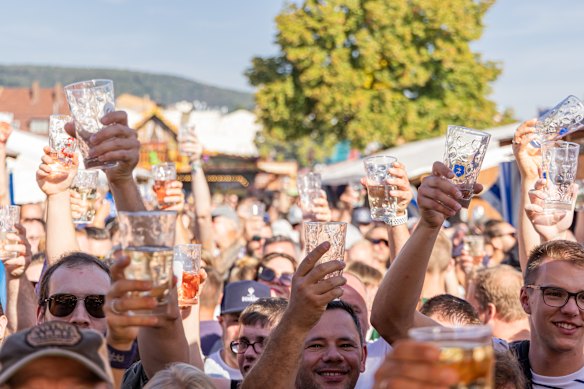 Crowds at Germany’s largest wine festival, Durkheimer Wurstmarkt.Heimatlichter GmbH
Crowds at Germany’s largest wine festival, Durkheimer Wurstmarkt.Heimatlichter GmbH
Here, the highlight isn’t a keg-tapping but this singalong at the morning Literarischer Frühschoppen or “literary brunch”. The crown goes not to the drunkest, but to the Wurstmarkt Wine Princess or Prince. And in Bad Dürkheim, whose chalk and sandstone soils are in the Palatinate heart of the Rhine Valley, Germany’s wine belt, the tipple was always going to be its signature grape: riesling.
It would be an understatement to say that the Wurstmarkt – literally “the sausage market” – is the main event of Bad Dürkheim’s calendar. At the entry to the grounds, which usually operates as a car park, a red timer blinks down until the festival’s mid-September launch. (As several residents told me sadly, one of the worst things about COVID was watching this, with no market to follow.)
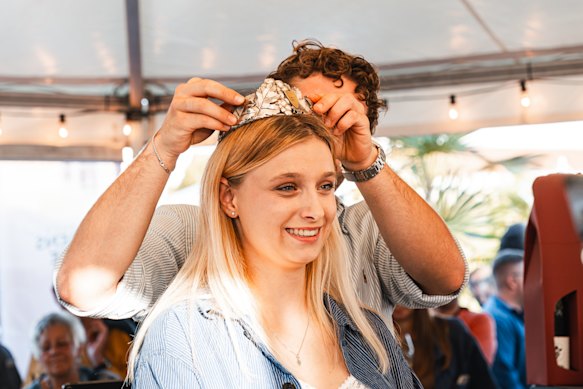 The Durkheimer Wurstmarkt Princess is crowned.Jonatan Quantz Fotografie
The Durkheimer Wurstmarkt Princess is crowned.Jonatan Quantz Fotografie
At zero, this western German town of 18,000 swells with over 600,000 visitors from across the country – all ready for a grape festival.
Pendulum rides, bumper cars and the locals’ beloved Jupiter ferris wheel tower over it all. The Weindorf (wine village) rises in the centre. Stalls line the food alley with Palatine favourites: Dampfnudel, steamed buns in wine sauce; Saumagen, pig stomach stuffed with pork, vegetables and potatoes, firmly smushed into bread.
Perhaps the most essential moment is when the Schubkarchstände, or “wheelbarrow stands”, are rolled into the festival tents. Today, these stands operate as narrow wooden tables and benches, with diehards arriving at 3am just to grab them. This makes it all the more impressive when they dance on them later.
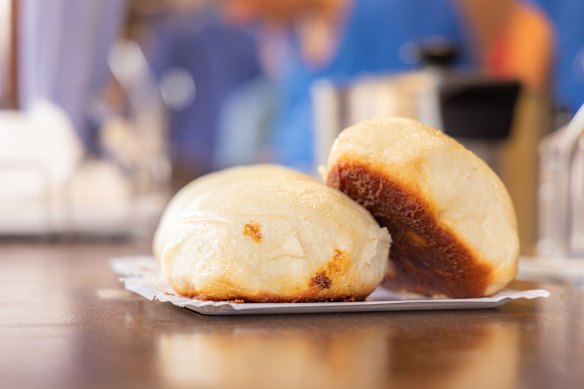 Dampfnudel, steamed buns in wine sauce.Heimatlichter GmbH
Dampfnudel, steamed buns in wine sauce.Heimatlichter GmbH
But these wheelbarrow tables trace back more than 600 years, when Bad Dürkheim sat beside the pilgrimage site of Michelsberg hill. You can still visit – the hill is just five minutes from the world’s largest wine barrel, where you can even eat lunch inside.
Enterprising locals would haul their goods up the hill in wheelbarrows to sell to pilgrims. After all, they reasoned as they carted up wurst and wine: surely bodies, as well as souls, needed feeding?
The predictable result was an all-out party that rubbed pious priests the wrong way. But instead of shutting down the lucrative spectacle, the local ruler moved it to the meadow below, where the Wurstmarkt remained.
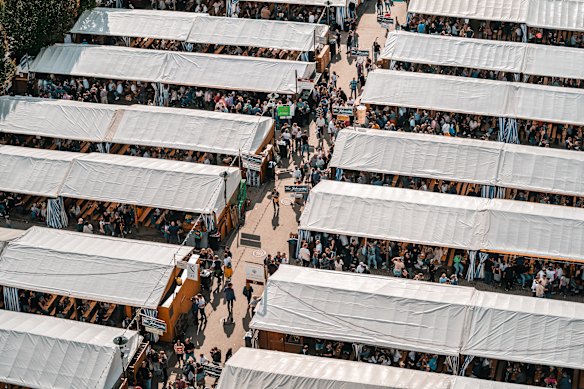 The Schubkarchstände, or “wheelbarrow stands”, are rolled into the festival tents.Jonatan Quantz Fotografie
The Schubkarchstände, or “wheelbarrow stands”, are rolled into the festival tents.Jonatan Quantz Fotografie
The love of celebration goes back even further. A half-hour’s walk through the vines leads to the remains of a Roman winery. Beside it are villa ruins, shaded by fig trees and scattered with tombs, which draw locals for summer feasts with wine.
In the valley, the festivities go on, far from thoughts of revellers from centuries gone by. There are no signs of the stumbling, beer-soaked, Dirndl and Lederhosen crowd you get at Oktoberfest. Instead, school friends – and new friends, in my case – are more exuberantly hugged, more frequently, and much longer.
Now, locals gather at the stage, and I find myself part of a small crowd, eager to see one of their own crowned the Wine Princess – the town’s representative for the next 12 months.
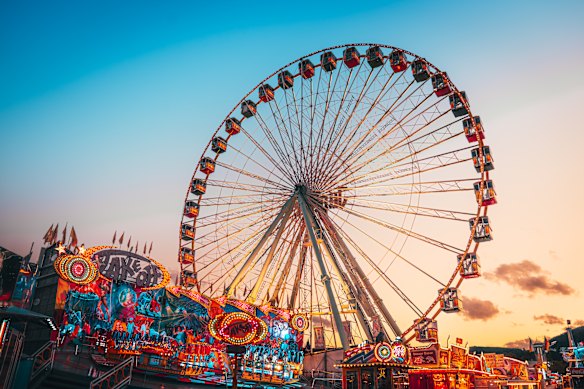 The Jupiter ferris wheel.Jonatan Quantz Fotografie
The Jupiter ferris wheel.Jonatan Quantz Fotografie
The old prince, eyes red with tears, lifts his crown off before the crowd. He sets it carefully in a box, and a new tiara is placed on the head of the fresh-faced princess. She makes a speech, toasts are raised, and a line of past princes and princesses step forward to embrace her, each wearing a crown and bearing tribute.
The only problem? Everyone seems to have brought her the same gift: wine.
The details
Visit
The Wurstmarkt runs over two weekends each September, and entry is free. Most stalls are cash only, so bring euros. Food from stalls ranges from €4-14, up to €20 in restaurants. A weinschorle costs €5.50. Rides are about €20.
Don’t miss the Literarischer Frühschoppen singalong or the crowning of the Wine Princess – each happens just once during the festival.
Fly
Bad Dürkheim is about 90 minutes by car from Frankfurt Airport.
Stay
Rooms in town sell out months in advance, so book early or stay in nearby Neustadt an der Weinstraße or Mannheim. See bad-duerkheim.de
The writer was a guest of Stadtverwaltung Bad Dürkheim, Pfalz Tourism and Alte Schmelz Inn.
Sign up for the Traveller Deals newsletter
Get exclusive travel deals delivered straight to your inbox. Sign up now.
Save
You have reached your maximum number of saved items.
Remove items from your saved list to add more.
Traveller GuidesFrom our partners


Dining and Cooking